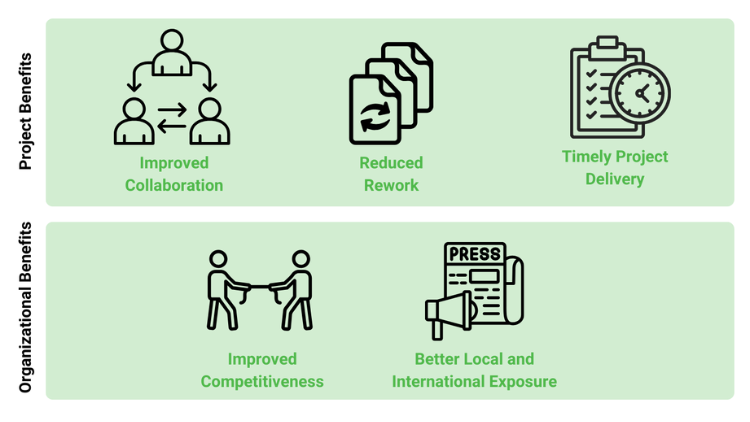
National Strategic Hub BIM Research
Findings on adoption
The research revealed that BIM adoption in the South African architecture, engineering, construction, and operations (AECO) industry is at level 1, meaning there is partial collaboration between project stakeholders due to differing adoption of BIM processes and the enabling technologies. Most firms and professionals within the South African AECO industry still rely primarily on two-dimensional CAD workflows that strain the level of collaboration possible in project teams.

This uncollaborative BIM environment stems from the following:
- Skills and capacity gaps: In South Africa, educational institutions that produce AECO graduates do not teach digital skills like BIM to learners because digital skills are not included in the core competencies set by governing bodies such as the South African Council for the Architectural Profession (SACAP). The lack of capacity is further illustrated by only 28% of professionals noting that they have BIM certifications. For sustainable capacity development, governing bodies must collaborate with the private sector to ensure that future skills competencies align with the skills demand of the South African AECO industry.
- Lack of mandates and national annexe: The ISO 19650 global BIM standards have been accepted as a South African National Standard (SANS). However, there is a lack of a national annexe that clarifies country-specific modifications of the standard to ensure that the ISO standards apply to the particularities of the local AECO industry and guide future government mandates. Also, government contracts and public sector projects do not mandate BIM processes, reducing industry-wide adoption incentives.
- High cost of implementation: It was found, as per the conducted survey and interviews, that professionals and organizations in the South African AECO private sector, particularly architectural firms, spend an average of 14% of their revenue on BIM authoring tools like Autodesk Revit. Professionals see this factor as the primary difficulty. Therefore, the industry must explore the use of free, open-source authoring tools guided by open standards in particular industry foundation classes (IFC) maintained by Building Smart International. One of the free authoring tools that shows promise is Bonsai, a Blender add-on in development by IfcOpenShell. Bonsai authors BIM models directly in IFC and aims to be a free and sustainable alternative to the proprietary BIM authoring tools.

Local adoption success stories
Despite these challenges, firms such as Zutari, Wolff Architects, dhk Architects, and SAOTA, who have invested in skills development and BIM-enabling technologies, have seen improved coordination, reduced rework, and timely project delivery. Beyond the project-specific benefits, their investment in BIM has allowed them to secure high-value projects in local and international markets such as the Middle East, where BIM adoption is key to obtaining construction projects.
